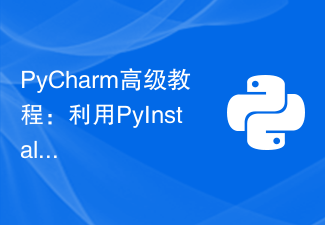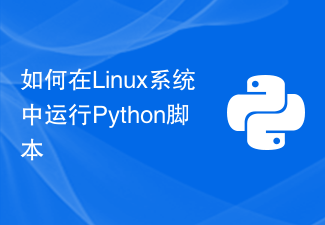 Backend Development
Backend Development Python Tutorial
Python Tutorial Use Python script operations to monitor and manage processes in Linux
Use Python script operations to monitor and manage processes in Linux
Title: Python script implements process monitoring and management in Linux
Abstract:
This article introduces how to use Python script to monitor processes in Linux systems and management. By writing Python scripts, we can easily implement process monitoring and management operations, including querying process information, starting new processes, stopping specified processes or stopping processes in batches, etc. Specific code examples will be given later. By studying this article, readers can master the basic methods of using Python scripts to monitor and manage Linux processes.
Keywords:
Python script, Linux process, monitoring, management, code examples
Introduction:
In the Linux system, the process is the basic unit running in the operating system. Process monitoring and management are of great significance to ensure the stable operation of the system and the reasonable allocation of resources. The traditional operation method mainly relies on command line tools, and the operation is not flexible and convenient enough. As a simple, easy-to-use, feature-rich programming language, Python provides powerful process monitoring and management capabilities, and can easily implement various operations.
1. Query process information
Python provides the psutil library, which can easily query and process process-related information. The following is a sample code that can query the PID, name, status and other information of the specified process.
import psutil
def query_process(process_name):
for proc in psutil.process_iter(['pid', 'name', 'status']):
if proc.info['name'] == process_name:
print(f"PID: {proc.info['pid']}, Name: {proc.info['name']}, Status: {proc.info['status']}")
query_process("python")By calling the psutil.process_iter() function, we can get the iterators of all processes in the current system, and then traverse to get the information of each process. By comparing the names of processes, we can filter out the processes we need to query. Here we take querying the Python process as an example.
2. Start a new process
Sometimes we need to start a new process through a Python script. Python's subprocess module provides corresponding functions. The following is a sample code:
import subprocess
def start_process(cmd):
subprocess.Popen(cmd)
start_process("ls -l")By calling the subprocess.Popen() function and passing in the corresponding command line instructions, you can start a new process. Here we take starting the ls -l command as an example.
3. Stop the process
In certain scenarios, we may need to stop the specified process. This function can be easily implemented using Python scripts. The following is a sample code:
import os
def stop_process(pid):
os.kill(pid, signal.SIGTERM)
stop_process(1234)Calling the os.kill() function, we can send a signal to the specified process to stop the process. Here we take stopping the process with PID 1234 as an example.
4. Stop processes in batches
When you need to stop multiple processes at the same time, it is more convenient to use Python scripts. The following is the sample code:
import psutil
def stop_all_processes(process_name):
for proc in psutil.process_iter(['pid', 'name']):
if proc.info['name'] == process_name:
os.kill(proc.info['pid'], signal.SIGTERM)
stop_all_processes("python")By traversing all processes, we can filter out the processes that need to be stopped and send a stop signal to them using the os.kill() function. Here we take stopping all Python processes as an example.
Conclusion:
This article introduces the basic method of using Python scripts to monitor and manage processes in Linux systems, and provides corresponding code examples. By writing Python scripts, we can easily implement operations such as querying, starting and stopping processes. Readers can further expand and apply it according to specific needs. By mastering these basic methods, we can more flexibly monitor and manage the processes in the system and improve the operating efficiency and stability of the system.
The above is the detailed content of Use Python script operations to monitor and manage processes in Linux. For more information, please follow other related articles on the PHP Chinese website!
 使用pyjokes创建随机笑话的Python脚本Sep 13, 2023 pm 08:25 PM
使用pyjokes创建随机笑话的Python脚本Sep 13, 2023 pm 08:25 PM您想为您的Python脚本或应用程序添加一些幽默吗?无论您是构建聊天机器人、开发命令行工具,还是只是想用随机笑话自娱自乐,pyjokes库都可以为您提供帮助。借助pyjokes,您可以轻松生成各种类别的笑话,并根据您的喜好进行自定义。在这篇博文中,我们将探讨如何使用pyjokes库在Python中创建随机笑话。我们将介绍安装过程、生成不同类别的笑话、自定义笑话、在控制台应用程序或网页中显示它们,以及处理可能发生的任何潜在错误。安装pyjokes在我们开始使用pyjokes创建随机笑话之前,我们需
 用于监控网站变化的Python脚本Aug 29, 2023 pm 12:25 PM
用于监控网站变化的Python脚本Aug 29, 2023 pm 12:25 PM在当今的数字时代,了解网站上的最新变化对于各种目的都至关重要,例如跟踪竞争对手网站上的更新、监控产品可用性或随时了解重要信息。手动检查网站是否有更改可能既耗时又低效。这就是自动化发挥作用的地方。在这篇博文中,我们将探讨如何创建Python脚本来监控网站更改。通过利用Python的强大功能和一些方便的库,我们可以自动化检索网站内容、与以前的版本进行比较并通知我们任何更改的过程。这使我们能够保持主动并及时对我们监控的网站上的更新或修改做出反应。设置环境在开始编写脚本来监控网站更改之前,我们需要设置P
 PyCharm高级教程:利用PyInstaller将代码打包为EXE格式Feb 20, 2024 am 09:34 AM
PyCharm高级教程:利用PyInstaller将代码打包为EXE格式Feb 20, 2024 am 09:34 AMPyCharm是一款功能强大的Python集成开发环境,提供了丰富的功能和工具来帮助开发者提高效率。其中,PyInstaller是一个常用的工具,可以将Python代码打包为可执行文件(EXE格式),方便在没有Python环境的机器上运行。在本篇文章中,我们将介绍如何在PyCharm中使用PyInstaller将Python代码打包为EXE格式,并提供具体的
 Python脚本自动刷新Excel电子表格Sep 09, 2023 pm 06:21 PM
Python脚本自动刷新Excel电子表格Sep 09, 2023 pm 06:21 PMPython和Excel是两个强大的工具,结合起来可以开启自动化世界。Python具有多功能的库和用户友好的语法,使我们能够编写脚本来有效地执行各种任务。另一方面,Excel是一种广泛使用的电子表格程序,它为数据分析和操作提供了熟悉的界面。在本教程中,我们将探索如何利用Python来自动化刷新Excel电子表格的过程,从而节省我们的时间和精力。您是否发现自己花费了宝贵的时间使用更新的数据手动刷新Excel电子表格?这是一项重复且耗时的任务,可能会真正降低生产力。在本文中,我们将指导您完成使用Py
 完全指南:确保准确查看Django版本Feb 19, 2024 pm 06:33 PM
完全指南:确保准确查看Django版本Feb 19, 2024 pm 06:33 PM专业指南:如何准确查看Django版本,需要具体代码示例引言:Django是一个高度受欢迎的PythonWeb框架,其不断更新的版本对于开发者来说非常重要。查看Django版本对于确保使用最新功能和修复了的漏洞至关重要。本文将介绍如何准确查看Django版本,并提供具体的代码示例。一、使用命令行查看Django版本使用命令行是最简单快捷的方式来查看Djan
 Flask安装配置教程:轻松搭建PythonWeb应用的利器Feb 20, 2024 pm 11:12 PM
Flask安装配置教程:轻松搭建PythonWeb应用的利器Feb 20, 2024 pm 11:12 PMFlask安装配置教程:轻松搭建PythonWeb应用的利器,需要具体代码示例引言:随着Python的日益流行,Web开发也成为了Python程序员的必备技能之一。而要进行Python的Web开发,我们需要选择合适的Web框架。在众多的PythonWeb框架中,Flask是一款简洁、易上手且灵活的框架,备受开发者们的青睐。本文将介绍Flask框架的安装、
 如何在Linux系统中运行Python脚本Oct 05, 2023 am 08:05 AM
如何在Linux系统中运行Python脚本Oct 05, 2023 am 08:05 AM如何在Linux系统中运行Python脚本作为一种强大的脚本语言,Python在Linux系统中广泛应用。在本文中,我将为你介绍如何在Linux系统中运行Python脚本,并提供具体的代码示例。安装Python首先,确保你的Linux系统上已经安装了Python。在终端中输入以下命令来检查系统是否已安装Python:python--version如果显示了
 Linux系统中常见的CPU问题及其解决方法Jun 18, 2023 pm 06:11 PM
Linux系统中常见的CPU问题及其解决方法Jun 18, 2023 pm 06:11 PMLinux操作系统已经成为了互联网基础架构的标配之一,其可靠性和灵活性让它成为了许多企业和组织的首选操作系统。然而,在使用Linux系统时,也会经常遇到一些CPU方面的问题,这些问题可能会对系统的性能和稳定性产生严重的影响。本文将介绍一些在Linux系统中常见的CPU问题及其解决方法。频繁的CPU过载CPU过载是一种常见的问题,尤其是那些运行重负载应用程序的


Hot AI Tools

Undresser.AI Undress
AI-powered app for creating realistic nude photos

AI Clothes Remover
Online AI tool for removing clothes from photos.

Undress AI Tool
Undress images for free

Clothoff.io
AI clothes remover

AI Hentai Generator
Generate AI Hentai for free.

Hot Article

Hot Tools

SublimeText3 Mac version
God-level code editing software (SublimeText3)

SAP NetWeaver Server Adapter for Eclipse
Integrate Eclipse with SAP NetWeaver application server.

Atom editor mac version download
The most popular open source editor

mPDF
mPDF is a PHP library that can generate PDF files from UTF-8 encoded HTML. The original author, Ian Back, wrote mPDF to output PDF files "on the fly" from his website and handle different languages. It is slower than original scripts like HTML2FPDF and produces larger files when using Unicode fonts, but supports CSS styles etc. and has a lot of enhancements. Supports almost all languages, including RTL (Arabic and Hebrew) and CJK (Chinese, Japanese and Korean). Supports nested block-level elements (such as P, DIV),

SecLists
SecLists is the ultimate security tester's companion. It is a collection of various types of lists that are frequently used during security assessments, all in one place. SecLists helps make security testing more efficient and productive by conveniently providing all the lists a security tester might need. List types include usernames, passwords, URLs, fuzzing payloads, sensitive data patterns, web shells, and more. The tester can simply pull this repository onto a new test machine and he will have access to every type of list he needs.





